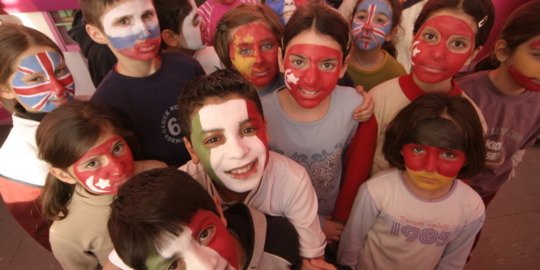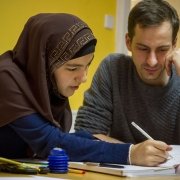Staatliche Europa-Schule Berlin (SESB) / State Europe School Berlin (SESB)
Excerpt
The State Europe School Berlin (SESB) is a state-run school that consciously does not regard itself as an elite school. It rather aims to enable a social mix and consistent bilingualism for all its pupils through to completion of secondary school. According to the mother tongue principle, foreign students should continue to learn the language of their parents and German children should, due to the equal footing of the other language (partner language), learn this language both naturally and more intensely. School timetables, class and teaching staff composition should, in line with the parity principle, be made up of 50% German native speakers and the remaining 50% of native speakers of the partner language. Selection should not be made with regards to a talent for language or any previous knowledge. The SESB has been existing since 1992 and are now successfully established as a special pedagogical concept. The following partner languages are offered within the SESBs (as of May 2018): English, French, Spanish, Italian, Greek, Polish, Portuguese, Russian and Turkish.
Narrative, origins and objectives of the initiative
What kind of project is this? Please give a short description (summary) of it.
The State Europe School Berlin (SESB) is a state-run school that consciously does not regard itself as an elite school. It rather aims to enable a social mix and consistent bilingualism for all its pupils through to completion of secondary school. According to the mother tongue principle, foreign students should continue to learn the language of their parents and German children should, due to the equal footing of the other language (partner language), learn this language both naturally and more intensely. School timetables, class and teaching staff composition should, in line with the parity principle, be made up of 50% German native speakers and the remaining 50% of native speakers of the partner language. Selection should not be made with regards to a talent for language or any previous knowledge. The SESB has been existing since 1992 and are now successfully established as a special pedagogical concept. The following partner languages are offered within the SESBs (as of May 2018): English, French, Spanish, Italian, Greek, Polish, Portuguese, Russian and Turkish.
Please tell us why, in general, this project is considered a successful one?
The project seeks to support interculturalism and bilingualism at the same time. Interculturalism is promoted by allowing children who are non-native speakers of German to live and experience their own native language and culture within the normal school system, alongside the German language and culture represented by German native speakers among teaching staff and students. This is supported by the a balanced recruitment of teachers and students that are German native speakers and native speakers of the foreign partner language spoken in the respective school. Bilingualism is promoted across all subjects with approximately half of all lessons being taught in German and the other half in the foreign partner language.
Apart from promoting bilingualism and interculturalism, the SESBs prepare children and young people for the working world of the future. Bilingualism is a great advantage for the youth of a mainly export-oriented country, which is increasingly taking on a bridging function between Western and Eastern Europe, and thus one of the most important competencies that the school can bring to life.
And why would you consider it a grass-roots initiative?
In view of the increasing internationalization of Berlin - particularly after the reunification of Germany in 1989 - parent associations (supported by the Europa Union Berlin) began to promote the opening of a European-oriented form of education in the 1980s. The aim was to promote linguistic diversity in schools through new pedagogical concepts and forms of learning. The first SESBs were founded in 1992 as school experiments offering bilingual education for its entire curriculum with three language branches (German-French, German-English, German-Russian). In 2011, the SESBs were recognized as forming part of the official school system of the Federal State of Berlin as "schools of special pedagogic character".
What challenges needed to be solved in this project?
A large number of SESBs are situated in the Western part of Berlin, which may restrict accessibility for those residing in districts in East-Berlin. The Federal State of Berlin has therefore decided to put a particular emphasis on increasing the provision in school districts in East-Berlin.
Moreover, the demand for English, French and Spanish outstrips the supply of places among native speakers of the partner language and German native speakers, while the demand for SESBs with other partner languages have much more limited demand among German native speakers. While the intention is to have a balanced enrollment of German native speakers and native speakers of the partner language, the share of German native speakers at SESBs with a partner language other than English, French or Spanish ranges between 2 and 17 percent. This has resulted in the Federal State of Berlin indicating a more flexible approach in future, with regard to the goal of balanced enrollment at SESBs.
Is this initiative based on any particular theoretical framework? Which one?
The initiative is based on the concept of language immersion, whereby language acquisition / bilingualism is sought to be promoted through the use of the respective two languages for instruction in a variety of topics, rather than specifically through language tuition. The languages used for instruction are referred to as L1 (native language) and L2 (second language). Although, in many cases the overall goal is that of promoting bilingualism, interculturalism is also a goal for speakers of the majority language compared to those of the minority language.
(Appendix) Is your intervention standing on its own or is it a part of a bigger and more holistic approach?
In view of the increasing internationalization of Berlin - particularly after the reunification of Germany in 1989 - the Federal State Berlin has responded to the requests of parents' associations to promote interculturalism by first piloting SESBs and then establishing them as "schools of special pedagogic character" within the official school system of the Federal State of Berlin.
Please describe the group(s) intended as beneficiaries of this initiative
Why has this group (have these groups) been chosen?
The development of the SESBs has been promoted by parents’ associations in view of the increasing internationalisation of Berlin - particularly following the reunification of Germany in 1989. This was done both to promote bilingualism as well as interculturalism in schools. Through the SESBs children have the opportunity to benefit from bilingual lessons from primary education up to upper secondary education level. The acquisition of the partner language, social and cultural exchange between native speakers of German as well as of the partner language are interconnected in the SESB. The SESBs seek to have a balanced intake of students that are German native speakers and students that are native speakers of the partner language of the school.
Could you please tell us something about the relative size of the (of each) target group, within the school/university population, region and/or country?
There are about 31 locations of SESBs in the Federal State of Berlin, of which 17 are primary schools and 14 secondary schools with nine language combinations, namely English, French, Spanish, Italian, Greek, Polish, Portuguese, Russian and Turkish. About 7,000 pupils are attending SESBs.
Which social characteristics are taken into account and what is the geographical area covered?
The students come from monolingual German-speaking, purely foreign-language or bilingual families. The following partner languages are offered within the SESB (as of May 2018): English, French, Spanish, Italian, Greek, Polish, Portuguese, Russian and Turkish. Students may opt to attain the regular secondary education school degree together with a B2 Certificate of the Common European Framework of Reference for Languages (CEFR) in the partner language. They may also choose to continue up to upper secondary education and attain the Abitur together with a C2 Certificate of the CEFR in the partner language. The geographical area covered are all school districts in the Federal State of Berlin, where SESBs form part of the regular school system as "schools of special pedagogic character".
On which level is the project implemented?
The initiative is implemented at three different levels, having an impact on:
- the students recruited (seeking for balance between German native speakers and native speakers of the partner language);
- the staff recruited (seeking for a balance of between German native speakers and native speakers of the partner language)
- and the teaching of the curriculum being conducted equally in German and the partner language.
The initiative is implemented at primary, secondary and upper secondary level. It is being supported and monitored at Federal State level.
Please describe the political and socio-economic factors that you believe have been important enablers for your initiative
Did the initiative have political support?
The SESBs have been supported by the Federal State of Berlin first as school experiments during the period 1992-2011 and then as part of the regular school landscape of the Federal State of Berlin as schools of special pedagogical character from 2011 onward.
In its coalition agreement for the legislative period 2016 to 2021, the governing coalition of the state of Berlin has agreed on the further expansion of the SESBs. According to the coalition agreement, the "successful offer of the Berlin State European School [...] will be further expanded on the basis of the evaluation, taking into account that locations in the eastern districts will also be set up".
How did it fit with local, regional or national policies?
Berlin is a Federal State with a particularly high share of families with a migration background that are native speakers of foreign languages. The integration of these families and their children is of importance and the SESBs contribute to this end by fostering interculturalism and bilingualism in schools by allowing children that are non-native speakers of German to be taught in their own native language, alongside teaching in German.
Who are the stakeholders supporting the initiative?
The initiative was particularly promoted by parents’ associations and the Europa Union Berlin in response to the increasing internationalisation of Berlin following the reunification of Germany in 1989.
Are there particular demographic changes present that are influencing the project?
The influx of refugees has had an impact on the demand for the SESBs. The Federal State of Berlin has responded by allowing refugees to have their mother tongue recognised as a second foreign language either through language certificates or through language tests. As a result, these children are exempt from having to learn a second foreign language, which allows them to dedicate more of their school time to the learning of German.
The increase of individuals with Arabic, Vietnamese or Chinese as a native language has also resulted in the Federal State of Berlin considering the establishment of SESBs in these languages.
What is the institutional strategy and culture of the (educational) organization?
SESBs are located in regular state schools, where they make up one to three strands of the regular school system of the Federal State of Berlin. Formally, the respective districts are responsible for the schools, while the Senate is responsible for the conception, the legal framework as well as the selection and hiring of staff. In addition, foreign-language teachers are deployed and funded by the respective partner countries at many SESB locations.
Interculturalism and bilingualism are ingrained in the institutional culture through the following three objectives:
- balanced recruitment of students (seeking for balance between German native speakers and native speakers of the partner language);
- balanced recruitment of staff (seeking for a balance of between German native speakers and native speakers of the partner language)
- balanced time dedicated to teaching of the curriculum in German and the partner language.
To what extent does the initiative have an influence on institutional policy (or potential influence) of the (educational) organization?
The intercultural and bilingual approach of the SESBs are further supported through extra-curricular activities throughout the day by addressing cultural habits, everyday experiences, festivals throughout the year and events for European Day. The European thought and cross-cultural activities are thereby highlighted.
Apart from that, the institutional policy of the SESBs includes a balanced recruitment of teaching staff among German native speakers and native speakers of the partner language.
(Appendix) Is there public support for your initiative and the issue it addresses?
Based on the initiative of parents’ associations and supported by the Europa Union Berlin, the SESBs were established as school experiments in 1992 in three language branches (German-English; German-French and German-Russian). In 2011, the SESBs were incorporated into the regular school landscape of the Federal State of Berlin as schools of special pedagogical character.
In its coalition agreement for the legislative period 2016 to 2021, the governing coalition of the state of Berlin has agreed on the further expansion of the SESBs. According to the coalition agreement, the "successful offer of the Berlin State European School [...] will be further expanded on the basis of the evaluation, taking into account that locations in the eastern districts will also be set up".
(Appendix) What other factors do you think have been important for the success of this initiative?
Moreover, the influx of refugees has had an impact on the demand for the SESBs. The Federal State of Berlin has responded by allowing refugees to have their mother tongue recognised as second foreign language either through language certificates or through language tests. As a result, these children are exempt from having to learn a second foreign language, which allows them to dedicate more of their school time to the learning of German.
The increase in individuals with Arabic, Vietnamese or Chinese as a native language has also resulted in the Federal State of Berlin considering the establishment of SESBs in these languages.
Please describe the overall initiative design and the methods and tools used to reach the goals
Please describe the specific activities carried out.
The SESB offers open bilingual education for all children from first grade to the post-secondary education level and is based on the school curriculum of the Federal State of Berlin. The school combines language acquisition with the concept of dual immersion, aiming to provide the framework for intercultural encounters. The special feature of this school form is the tripartite principle of parity:
Parity of the timetable: The curriculum is being taught in German and in the partner language in equal amounts.
Parity of staff: Teaching is provided by teachers and educators in their respective mother tongue, whereby pupils in the subjects German and their 1st foreign language (i.e. their partner language) are taught in small groups (typically 12 pupils) up to grade 9.
Parity of the student body: The students come from monolingual German-speaking, purely foreign-language or bilingual families and may acquire the middle school degree (MSA) after the 10th grade, or the Abitur (general entry qualification for higher education) at an integrated secondary school (ISS) or a Gymnasium (grammar school) after 12 or 13 years. The Abitur also certifies the highest language proficiency C2 according to the Common European Framework of Reference for Languages. From 5th grade, students will acquire another foreign language with English (the third foreign language in the German-English branch is French).
The following partner languages are offered within the SESBs (as of May 2018): English, French, Spanish, Italian, Greek, Polish, Portuguese, Russian and Turkish.
SESBs are located in regular state schools, where they make up one to three strands of the regular school system of the Federal State of Berlin. Formally, the respective districts are responsible for the schools, while the Senate is responsible for the conception, the legal framework and the selection and hiring of staff. In addition, foreign-language teachers are deployed and funded by the respective partner countries at many SESB locations.
What were the key roles (teacher, student, management team etc.) within the project?
SESBs seek to have a balanced intake of students and recruitment of teachers that are German native speakers or native speakers of the partner language of the school, as such students and teachers are key in promoting multi-culturalsm and bilingualism through immersion.
What ideas, tools, theories, models, methodology (etc.) have been used to reach the goals?
The methodology used is two-way immersion. This type, which is also called bilingual immersion, is a way to integrate both students of the minority language and students of the majority language into the same classroom with the goal of academic excellence and bilingual proficiency for both student groups. In this type of language immersion, the instructional languages can be two languages but only one language is used at a time. In SESBs the same amount of time is being dedicated to subjects taught in German and subjects taught in the partner language (L2) with teachers being recruited among German native speakers and native speakers of the partner language.
Language immersion is also characterised by the age at which language learning commences, namely into early immersion (second language learning commences after the age of 5 or 6), middle immersion (second language learning commences after the age of around 9 orr 10) and late immersion (second language learning commences after the age of 11). SESBs exist at primary, secondary and upper secondary education level. Hence, they can be considered as early immersion programmes.
What are the final revenues of the project?
The project is ongoing. Hence, no information on final revenues is available. The schools are funded through the state budget of the Federal State of Berlin.
Please describe if your project ensured its sustainability
If so, how did you ensure the short-term impact of the project?
The SESBs have been supported by the Federal State of Berlin first as school experiments during the period 1992-2011 and then as part of the regular school landscape of the Federal State of Berlin as schools of special pedagogical character from 2011 onward. The SESBs are now funded by the state budget of the Federal State of Berlin, ensuring their sustainability.
And how did you ensure the long-term impact of the project?
Since its original development as school experiment on the initiative of parents’ association and the Europa Union Berlin, the SESBs now form part of the regular school landscape of the Federal State of Berlin as schools of special pedagogical character. As such their funding and curriculum are regulated through the regular school system.
Has your project been replicated elsewhere?
Language immersion programmes exist since 1965, when in the majority French-speaking Quebec programmes were offered to meet the needs of English speaking minorities. In these programmes, French and English were taught based on the principle of two-way immersion. Since then English-French immersion programmes have expanded across Canada. Other language immersion programmes exist in the USA, Australia, China, Saudi Arabia, Japan and Hong Kong, with immersion programmes existing in more than 20 different languages. The most common languages taught in immersion programmes are Spanish, French and Mandarin.
Please tell us about the resources used in this initiative
What was the budget for the initiative?
This information is not available.
How much did the initiative depend on volunteers?
The first activities to found a European school for the people of Berlin date back to 1978. In 1986, the committee “Internationale Schule für Europa” (AG ISFE) was created on the initiative of the Europa-Union Berlin. The AG ISFE first made the draft for the SESB implementation model. As of 1991, it supported the founding and development of the SESB. In 2011 the AG ISFE was renamed and founded as the AG SESB.
The committee AG-SESB meets regularly to keep itself updated on developments in the SESBs and to facilitate the exchange of information among the SESB locations, with interest groups in government, in the senate administration and other associations. It enables this school form to have a voice in the political field and ensures that the key elements of the SESB are maintained as the founders intended. It does so through a variety of ways:
- As the mouthpiece of the SESB, the committee has a close personal contact with the individual SESBs. It seeks to invite representatives of every SESB to its meetings. In this way it can combine valuable information from the different SESBs, collect best practice examples and provide the SESBs with targeted advice in the case of conflict.
- Through its regular meetings the committee encourages the exchange of information among the SESBs.
- The committee asks the educational spokespersons of the individual parties in the Berlin House of Representatives for support and an extension of the SESBs and also organize public discussions with them.
- The committee members are also active in parents’ and school committees throughout Berlin on order to make the interests of the SESBs visible.
- The committee meets regularly with representatives of the senate administration for an exchange of information.
- The committee also makes its position known publicly on issues concerning the SESBs - either through newspaper letters to the editor, public consultations or on its website.
https://www.europa-union-berlin.de/ag-sesb/in-english-ag-sesb/
How were the costs perceived by the public/the sector/other stakeholders?
Demand for SESBs has increased considerably since its inception in 1992. In 1992, the SESB started with 160 pupils in six elementary schools with three different language combinations: German-English, German-French and German-Russian. Today, more than 7,000 pupils attend the 17 primary schools and 14 secondary school locations with a total of nine language combinations.
The high demand for the SESBs suggests a positive reception by the general public.
To what extent did the initiative achieve its objectives?
Please describe the evidence to support the success of your initiative.
Demand for SESBs has increased considerably since its inception in 1992. In 1992, the SESB started with 160 pupils in six elementary schools with three different language combinations: German-English, German-French and German-Russian. Today, more than 7,000 pupils attend the 17 primary schools and 14 secondary school locations with a total of nine language combinations.
Between April 2014 and December 2016 the state of Berlin, represented by the city’s Senator for Education, Youth and Science, commissioned Professor Jürgen Baumert of the Max Planck Institute for Human Development (MPIB) and Professor Jens Möller of the Institute of Psychology at Kiel University (CAU) to scientifically monitor and evaluate the SESB. The Mercator Institute for Literacy and Language Education was the scientific cooperation partner for this project.
For the study the performance of students in the fourth and ninth grade at SESBs were analysed with regard to German and foreign language learning as well as performance in other subjects such as mathematics or natural sciences.
The study proved that dual immersion according to the model of SESB is a path to additive bilingualism with successful integration without performance arrears in the subjects. The partner language was acquired through the continuous bilingual instruction on an internationally competitive level. Moreover, the study indicated that German language competences were acquired at the same level as in regular, non-bilingual schools. Additional foreign languages were also acquired faster than through regular, non-bilingual schools. The study also indicated that the performance in other subjects was not affected. In addition, the study found that SESBs promoted social and intercultural competences and European understanding. Thus, in this school form, the integration of children from linguistic-cultural minority groups was achieved better than at other mainstream schools.
Did the intervention lead to any unintended (positive) outcomes?
Out of the around 7,000 students at the 31 SESBs over 80% have a migration background. It appears, therefore, that the SESBs are particularly attractive for families with a migration background and contribute effectively to their integration.
Besides that, it appears that SESBs offering bilingual teaching in English, French or Spanish are particularly in demand, which may outstrip the supply of available places.
For some languages, e.g. Italian SESBs, bilateral agreements exist with the partner country that accepts the final school qualifications as equivalent to the final school qualifications in the partner country. In the case of Italy, holders of a final school qualification from the German-Italian SESB do not have to pass the entry examination for higher education that are otherwise obligatory for foreigners wishing to enter higher education institutions in Italy.
What indicators (quantitative and qualitative) have you measured to demonstrate success?
A study commissioned by the state of Berlin and conducted by the Max Planck Institute for Human Development (MPIB) and the Institute of Psychology at Kiel University (CAU) in cooperation with the Mercator Institute for Literacy and Language Education evaluated the SESB.
For this study, the performance of students in the fourth and ninth grade at SESBs were analysed with regard to German and foreign language learning as well as performance in other subjects such as mathematics or natural sciences. In addition, the study found that SESBs promoted social and intercultural competences and European understanding. Thus, in this school form, the integration of children from linguistic-cultural minority groups was achieved better than at other mainstream schools.
(Appendix) How did you evaluate/monitor this intervention?
Between April 2014 and December 2016 the state of Berlin, represented by the city’s Senator for Education, Youth and Science, commissioned Professor Jürgen Baumert of the Max Planck Institute for Human Development (MPIB) and Professor Jens Möller of the Institute of Psychology at Kiel University (CAU) to scientifically monitor and evaluate the State Europe School Berlin. The Mercator Institute for Literacy and Language Education was the scientific cooperation partner for this project.










